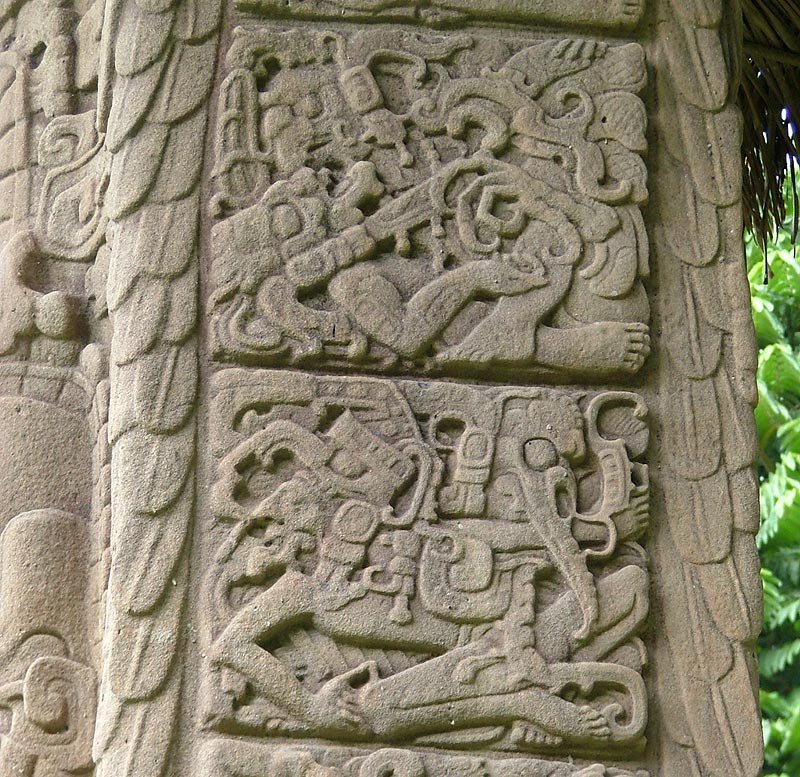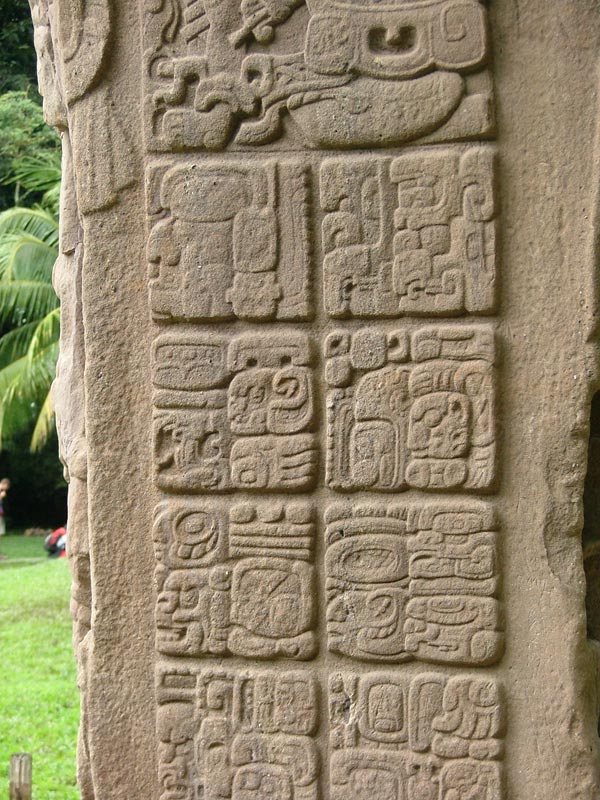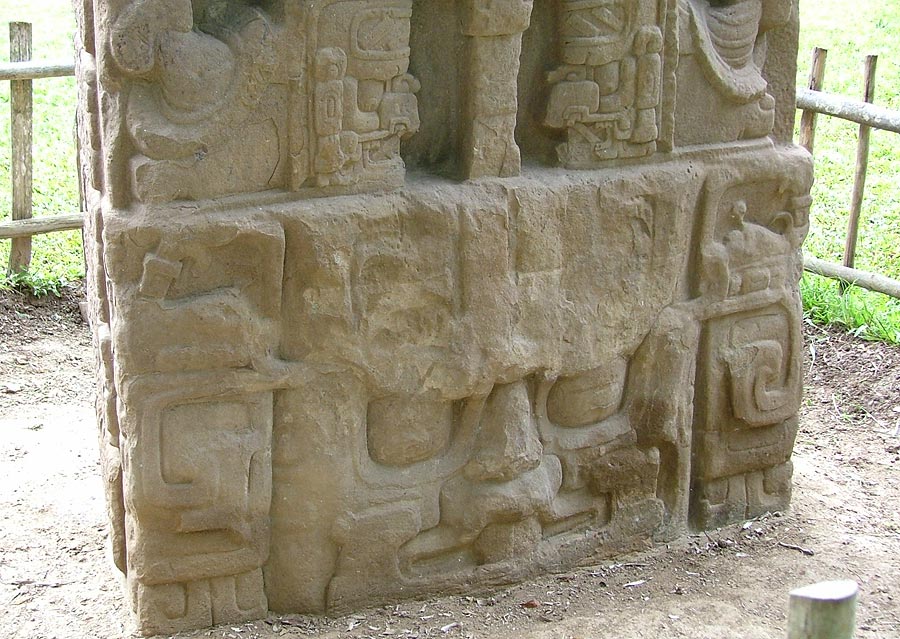

Map adopted from the map of the site core, Department of Izabal, Guatamala.
Photo is from M16
Click on GREEN ARROWS to view photos of major buidings and vistas
Click here for an annotated Quirigua reading list.
To help keep track of the Quirigua Monuments, here is a link to a spreadsheet of most of the Quirigua monuments in chronological order, with dedication date, ruler, and associated details from inscriptions. There are also links from the spreadsheet monument number to the section devoted to that monument.
"Quirigua was Copan's most important dependency, providing its rulers with strategic access to the trade routes and mineral resources of the Motagua River valley. For most of the Classic Period, Qirigua seems to have been governed by an offshoot of the dynasty of Yax K'uk' Mo', a bloodline that remained subject to the authority of the high kings at Copan.
Throughout their history, the rulers of Quirigua claimed Copan titles in the inscriptions of their monuments and even recorded their descent from Yax K'uk' Mo'.
In the reign of Cauac Sky, Quirigua's bonds of allegiance to the dominant site apparently began to fray. In A.D. 738 the two sites would go to war, driven by circumstances that are still not clearly understood.
Interestingly, in the aftermath of Copan's lost war [where Cauac Sky of Quirigua captured and sacrificed 18 Rabbit of Copan], the type of monumental strategy pursued by Smoke-Imix and 18-Rabbit was perpetuated at Quirigua.
The closest conterpart of their serial stelae groupings is the program of colossal sculptures erected by Cauac Sky following 18-Rabbit's demise. Cauac Sky's design for Quirigua's Great Plaza is strongly reminiscent of Copan's; his assembly of stelae, concentrated in this location, seems to reflect something of an appropriation of his former overlord's most important monumental work."
Elizabeth Newsome, Trees of Paradise and Pillars of the World: The Serial Stela Cycle of 18-Rabbit-God-K, King of Copan, p. 45

Quirigua: View of Grand Plaza looking North
"The plaza of this small site is majestic, presenting the visitor with an expanse of level courtyard that the towering stelae — the tallest soars to nearly 35 feet — separated into areas of enclosure and sweeping processional spaces.
Given Quirigua's modest size and population, one might wonder what ritual spectators and participants visited the site to take part in Cauac Sky's period-ending rites.
Who gathered at Quirigua to observe these celebrations? In the aftermath of a war that had separated the site from Copan and its hinterlands, what allies of Cauac Sky might have assembled to honor his claims to sovereign kingship?"
Elizabeth A. Newsome, Trees of Paradise and Pillars of the World: The Serial Stela Cycle of 18-Rabbit-God K, King of Copan, p. 64
Political alliances to control of the rich lower Motagua River trade routes may have driven these events. Alliances with the newly flourishing non-Maya sites in the lower river area or with the powerful but distant city of Calakmul may have been instrumental in Cauac Sky's victory.

View of the Grand Plaza looking North to Stelae E and F
Cauac Sky means "Thundercloud Sky". His Maya name was K'ak' Tiliw Chan Yopaat
18-Rabbit's name was Waxaklahun Ubah K'awil. His glyphs literally mean 18-Rabbit (or gopher)
The capture and sacrifice of 18-Rabbit of Copan was of over-riding significance to Cauac Sky and his descendants and was the basis of Cauac Sky's claim, which he continued to make to the end of his long life, that he was the legitimate 14th successor to Yax Kuk' Mo' of Copan [18-Rabbit was the 13th successor].
This claim, along with mention of the capture date of 18-Rabbit, is made on every monument Cauac Sky erected after the event occurred in 738 A.D.
Although the sacrifice of 18-Rabbit and the desecration of Copan's battle gods caused a major physiological crisis of confidence for Copan, neither city was either invaded or was forced to pay tribute after the battle. In fact, this action looks more like a raid than an actual war, resulting in Quirigua becoming independent of its vassel status and Copan avoiding a possible war against a neighbor with powerful allies.
However, Cauac Sky never gave up his claims that he was the legitimate 14th ruler of Copan.
The monuments featured in this section belong to the northern cluster of monuments which date from the last 24 years of Cauac Sky's reign, 761–785 A.D.

MONUMENT 6: Stela F, North Side. Erected by Cauac Sky in 761 A.D. or 9.16.10.0.0 longcount
Captured 18-Rabbit on April 25, 735
States Cauac Sky is 14th in line of Quirigua rulers
"Columnar stela standing 7.3 m [24 feet] above the present surface. This is the first monument dedicated on the northern Plaza Platform, and it appears to have set precedents for the rest of the stelae in this cluster.
Monument 6 initiates the practice of twin frontal portraits of Cauac Sky on the southern and northern sides, followed on Monuments 1, 3, 4, and 5 (although the northern portraits on Monuments 1 and 3 are variants in this pattern). The twin portraits on Monument 6 are very similar, but not duplicates."
Robert J. Sharer, Quirigua: A Classic Maya Center & Its Sculptures, Carolina Academic Press, 1990, p. 39

Stela F seen from the South East side, dedicated on March 15, 761 A.D. or 9.16.10.0.0 longcount
"The twin hieroglyphic texts on the east and west sides of Monument 6 are unique for Quirigua stelae (save Monument 11), in that they do not cover the entire length of the shaft. Rather, the Initial Series date begins beneath the elaborate feathers of Caac Sky's headdress that wraps around both sides of the sculpture.
The Initial Series dates are carved with head-variant numerals on both sides instead of the more common bar-and-dot notations. Using this more elaborate notation, the Initial Series date on the east side [shown here] records the dedicatory date of 9.16.10.0.0, while that on the west side records the inauguration of Cauac Sky's rule, 9.14.13.4.17 12 Caban 5 Kayab 724 A.D."
Robert J. Sharer, Quirigua: A Classic Maya Center & Its Sculptures, Carolina Academic Press, 1990, p. 41

The west side of Stela F (Monument 6), dedicated March 15, 761 A.D. or 9.16.10.0.0 longcount
The west side inscriptions records the inauguration date of Cauac Sky's rule and includes a clause recording the capture of 18 Rabbit, ruler of Copan.
The 1 Ahau dates link mythological sacrifices with Cauac Sky's historical sacrifice of 18-Rabbit, and are the basis of Cauac Sky's claim, which he continued to make to the end of his long life, that he therefore was the legitimate fourteenth successor in the Dynasty of Yax Kuk' Mo' of Copan.
NOTE: The "decapitation glyph" used in this passage describing mythological sacrifices is the same glyph used in passages describing the sacrifice of 18-Rabbit. It is the second from the left in the middle row of the photo. The diagonal element in the top half of the glyph represents a stone axe.

Stela E was dedicated on January 22, 771 A.D. or 9.17.0.0.0 long count date.
Guatemalan high school students and our own group visited on January 8, 2004 or 12.19.10.16.10
Stela E is the largest stela in the Maya area, and stela rises 26.5 feet tall above ground and is a massive 35 feet tall including its stone shaft. The north and south sides are carved with near-identical portraits of Cauac Sky.
The glyphic inscription on the west side of the Stela E commemorates the inauguration of Cauac Sky in 724 A.D. and includes the title of batab in the territory of 18 Rabbit of Copan, implying that when Cauac Sky came to power, Quirigua was a vassel state of Copan.
Sharer writes: "The text continues to relate events of Cauac Sky's reign, culminating in his victory over his former overlord, 18 Rabbit, ruler of Copan. Near the close of this inscription...the text again refers to Cauac Sky, batab, followed by the Zotz (leaf-nosed bat) main sign of the Copan "emblem glyph,", the capture glyph, the name of 18 Rabbit, and the Copan "glyph". This Copan "glyph" after Cauac Sky's name and title may refer to his claim to be ruler of that center, following his defeat of 18 Rabbit.
Robert J. Sharer, Quirigua: A Classic Maya Center & Its Sculptures, Carolina Academic Press, 1990, p. 39
Of course, this was wishful thinking on the part of Cauac Sky, because Copan's succesor Smoke Monkey, in the natural course of events, became 14th ruler of Copan in 738 A.D. after 18 Rabbit's death and ruled to 749. At the time Stela E was dedicated in 771 A.D., the 16th ruler of Copan, Yax Pasah, was involved in a prodigious building campaign in Copan designed in part to restore the confidence of his people.

Stela E (Monument 5), dedicated January 22, 771 A.D., 9.17.0.0.0 K'atun period ending date
In both cases, he holds a manikin scepter across the chest in the right hand, and a small round shield in the left. Although the nose has disappeared, the facial portrait on the northern side is the best preserved at Qirigua.

From the Maudslay Collection, British Museum. Used with permission under the CC BY-NC-SA 4.0 non-commercial license. ©he Trustees of the British Museum.
Before it vanished, this particular nose enjoyed a famous career. It first became detached while a mold was being taken in 1883 during Maudslay's third expedition. Maudslay had the nose cemented in place, and it remained there until 1917, when Monument 5, radically leaning ever since its discovery, finally slumped to the ground after a severe flood.
The nose was apparently dislodged in the fall, but Sylvanus G. Morley subsequently rescued the errant appendage. It was finally reattached using a metal tenon when the stela was re-erected in 1934, by Gustav Stromsvik. Incidentally, this operation resulted in the breaking of Monument 5, just beneath Cauac Sky's chin--close examination can still discern the crack and repair--when the A-frame use to hoist the heavy sclpture gave way, dropping it to the ground.
But in spite of these adventures, the fabled nose vanished sometime after it was replaced in 1934, so that Cauac Sky's best preserved likeness remains blemished."
Robert J. Sharer, Quirigua: A Classic Maya Center & Its Sculptures, Carolina Academic Press, 1990, p. 36

Stela D (Monument 4), Northeast Side, dedicated Feb. 17, 766 A.D. or 9.16.15.0.0 longcount
"The Initial Series dates on both the east and west sides are rendered in full-figure glyphs and are the most beautifully carved of any at Quirigua, if not the entire Maya area. The inscription on the east side is the best preserved--recording the 9.16.15.0.0 dedicatory date."
Robert J. Sharer, Quirigua: A Classic Maya Center & Its Sculptures, Carolina Academic Press, 1990, p. 34
Alfred Maudslay, who visited the ruins in 1882 and 1883, observed: "The design of these pictures-writings shows considerable variety and freedom of treatment as compared with that of the large-sized human figures, in the execution of which the artist seems to have been bound by conventional rules."
Anne Cary Maudslay. A Glimplse at Guatemala, and Some Notes on the Ancinet Monuments of Central America. Forgotten Books, London. Originally published London: John Murray 1899, p. 149
These ancient portraits forever bring to mind the line of William Butler Yeats: "A gaze blank and pitiless as the sun".

Stela D (Monument 4), Northeast Side, dedicated Feb. 17, 766 A.D. or 9.16.15.0.0 longcount
NOTE: there is an excellent longcount date converter here. Give it a try!
The Maya longcount date celebrated here is 9.16.15.0.0 — 7 Ahau 18 Pop, the date Stela D was dedicated (February 17, 766 A.D.)
The inscription starts with a [rather comical] Jaguar Initial Series Introductory Glyph representing the month Pop. The bottom glyph represents the time period of 9 Baktuns.
Robert Sharer writes: "The following columns of full-figure glyphs are each composed of two intertwined creatures, those on the left corresponding to the numerical coefficients, and those on the right symbolizing the long count periods.
The first of these is a youthful figure, apparently wearing a false beard, seated cross-legged and leaning to the left, representing the number 9, and holding the baktun on his lap."
Robert J. Sharer, Quirigua: A Classic Maya Center & Its Sculptures, Carolina Academic Press, 1990, p. 34

Stela D, also called Monument 4, East Side, dedicated Feb. 17, 766 A.D. or 9.16.15.0.0 longcount
"The next coefficien, 16, is depicted by a figure with a fleshless jaw (symbolizng the number 10) and an assumed cross in the eye, now weathered (to symbolize the number 6), lying on his back, and gazing upwards at the katun figure above.
The 15 tuns are represented by another figure with a fleshless jaw (number 10) and a headdress symbolizing the number 5, seated in a manner very similar to the baktun coefficient, and holding the tun symbol in his lap."
Robert J. Sharer, Quirigua: A Classic Maya Center & Its Sculptures, Carolina Academic Press, 1990, p. 34

Stela D, also called Monument 4, East Side, dedicated Feb. 17, 766 A.D. or 9.16.15.0.0 longcount
"The next two numbers correspond to zero, and each is represented by a figure with a lower jaw shaped like a hand. Zero uinal is depicted by a smiling figure whose face is facing front, prancing in front of a seated uinal figure."
Robert J. Sharer, Quirigua: A Classic Maya Center & Its Sculptures, Carolina Academic Press, 1990, p. 34

Stela D (Monument 4), East Side, dedicated Feb. 17, 766 A.D. or 9.16.15.0.0 longcount
"Zero kin is represented by a profile figure seated like the baktun and tun coefficient, holding the kin sign above his lap.
The final full-figure glyph block depicts a seated figure of the number 7, gazing upwards, and a portrait of the day, ahau, within an elegant day-sign cartouche. "
Robert J. Sharer, Quirigua: A Classic Maya Center & Its Sculptures, Carolina Academic Press, 1990, p. 34-5

Stela D (Monument 4), East Side, dedicated Feb. 17, 766 A.D. or 9.16.15.0.0 longcount
After the final full figure of the Initial Series date, the inscription changes to a double row of regular glyphs.

Stela D (Monument 4), West Side, dedicated Feb. 17, 766 A.D. or 9.16.15.0.0 longcount
The full-figure inscription on the west side is slightly less well preserved. Shown above are glyph sequences numbered 3 and 4 [left], 6 and 7 [right].

Stela D (Monument 4), North Side, dedicated Feb. 17, 766 A.D. or 9.16.15.0.0 longcount
Stela D is 19 1/2 feet tall. The north side has a portrait of Cauac Sky holding a manikin scepter in his left hand and the shield in his right.
A badly eroded frontal portrait of Cauac Sky also appears on the south side of the monument.
Robert J. Sharer, Quirigua: A Classic Maya Center & Its Sculptures, Carolina Academic Press, 1990, p. 34
Cauac Sky's headdress consists of two masks of supernatural beings topped with a skeletal head with lunar glyphs on either side.

Stela D (Monument 4) North Side, dedicated Feb. 17, 766 A.D. or 9.16.15.0.0 longcount
This may be a representation of the Jaguar Sun, or Sun at Night, when the sun makes its nightly journey through the underworld.

Stela D (Monument 4), North Side, dedicated Feb. 17, 766 A.D. or 9.16.15.0.0 longcount
Cauac Sky's sandal backs are worthy of our attention. They represent a pair of supernatural beings staring at each other from ankle to ankle.